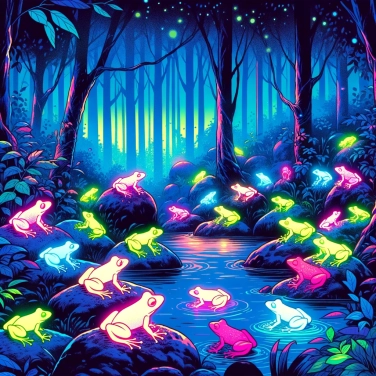Some frogs are fluorescent in the dark due to the presence of molecules called hyloins in their skin. These molecules reflect ultraviolet light and transform it into visible light, creating this luminescent effect.

In some frogs, nocturnal fluorescence comes from particular molecules located beneath their skin. These compounds absorb ultraviolet (UV) light and then re-emit that energy in the form of visible light, often green or blue. This phenomenon mainly depends on substances called hyloins that are naturally present in their tissues, and sometimes on specific pigments incorporated directly into their epidermis. When the frog is exposed to UV light — such as that from the moon or certain artificial lights — these molecules come into action and give their skin that surprising fluorescent glow.
Some tropical frogs have astonishing fluorescence. This is the case for the spotted tree frog (Hypsiboas punctatus), a small frog from South America that appears ordinary in daylight but emits a bright blue-green light under ultraviolet light. Another remarkable fluorescent frog is the polka-dot frog (Boana atlantica) discovered in Brazil, which reveals stunning shades of blue and green on its skin under UV light. Other small frogs of the genus Brachycephalus, very common in South America, illuminate with bright orange hues under ultraviolet rays. Recent studies have identified even more fluorescent frogs in Africa, Asia, and even Australia, indicating that this phenomenon is likely much more widespread in the amphibian kingdom than previously thought.
Fluorescence in frogs could have several useful roles. For example, it may increase their visibility at night to other frogs, thus facilitating visual communication during the breeding season. In some species, this would also aid in individual recognition and help avoid confusion with other similar species. Another hypothesis is that this fluorescence could serve to warn potential predators that the frog is toxic or unpalatable, acting as a natural deterrent sign. This clever adaptation would therefore provide them with a significant advantage to enhance their survival by increasing their selective visibility while discouraging predators.
Recent studies have revealed that the fluorescence of frogs mainly comes from specific molecules called hyloins, found in their skin and glands. Scientists have also discovered that this fluorescent phenomenon, which was thought to be rare, is actually surprisingly common in many amphibian species. Recently, researchers observed several ordinary frogs under UV light, which had previously seemed unremarkable on the subject – surprise: they glowed too! Even more intriguing, these studies show intense fluorescence primarily concentrated in the body parts used for visual communication, such as the legs or certain specific areas of their skin. This prompts scientists to seek a more concrete link between fluorescence and the social behaviors of frogs, including their reproduction.
This fluorescence can be quite a boost for communication among frogs: better distinction would facilitate interactions between partners or species recognition. Conversely, caution should be exercised regarding potential backlash, as becoming highly visible may make them more easily attractive to their predators. By subtly altering the relationships between prey and predators, this luminous characteristic could have broader ecological impacts, influencing balances within the ecosystem. Furthermore, fluorescence could also affect interactions with other organisms, such as insects, thereby modifying subtle yet important links in their natural environment.
The pigment responsible for green fluorescence in certain frogs, called hyloin-L1, could be useful for future medical research, particularly in better understanding certain skin conditions.
The fluorescence of frogs may also play a role in intraspecific communication, facilitating the recognition of conspecifics in low-light nocturnal environments.
Fluorescence in frogs is not solely the result of a chemical reaction: sometimes, it is simply the absorption and then re-emission of light at a different wavelength, thanks to specific pigments sourced from their diet.
Researchers discovered fluorescence in frogs almost by chance, thanks to the unexpected use of a UV lamp during a nighttime scientific excursion in a tropical forest.
Sure! Here’s the translation: "Yes, various scientists propose the hypothesis that fluorescence could play a role in the recognition between individuals of the same species or in attracting partners during nocturnal reproduction. However, these potential roles are still under discussion and are part of the latest research."
Yes, several other animals exhibit natural fluorescence, including various fish, sharks, scorpions, and even some sea turtles. This phenomenon is not specific to frogs, but rather represents a broad area of research in marine and terrestrial biology.
No, fluorescence is not dangerous for frogs. On the contrary, it may offer certain advantages, such as facilitating communication between individuals or helping to protect against nocturnal predators, although research is still ongoing to better understand these potential benefits.
The fluorescence of frogs is rarely visible to the naked eye in natural conditions. To clearly detect it, it is generally necessary to use a special UV lamp that reveals the typical green or blue glow of certain fluorescent species.
No, fluorescence has been discovered in several distinct groups of frogs that are not necessarily closely related. This suggests that this trait may have developed independently at different times during evolution.
Frogs become fluorescent due to the presence of specific molecules in their skin that can absorb ultraviolet light and reemit it as visible light. This biological phenomenon, known as fluorescence, is often associated with particular proteins or pigments.

No one has answered this quiz yet, be the first!' :-)
Question 1/5